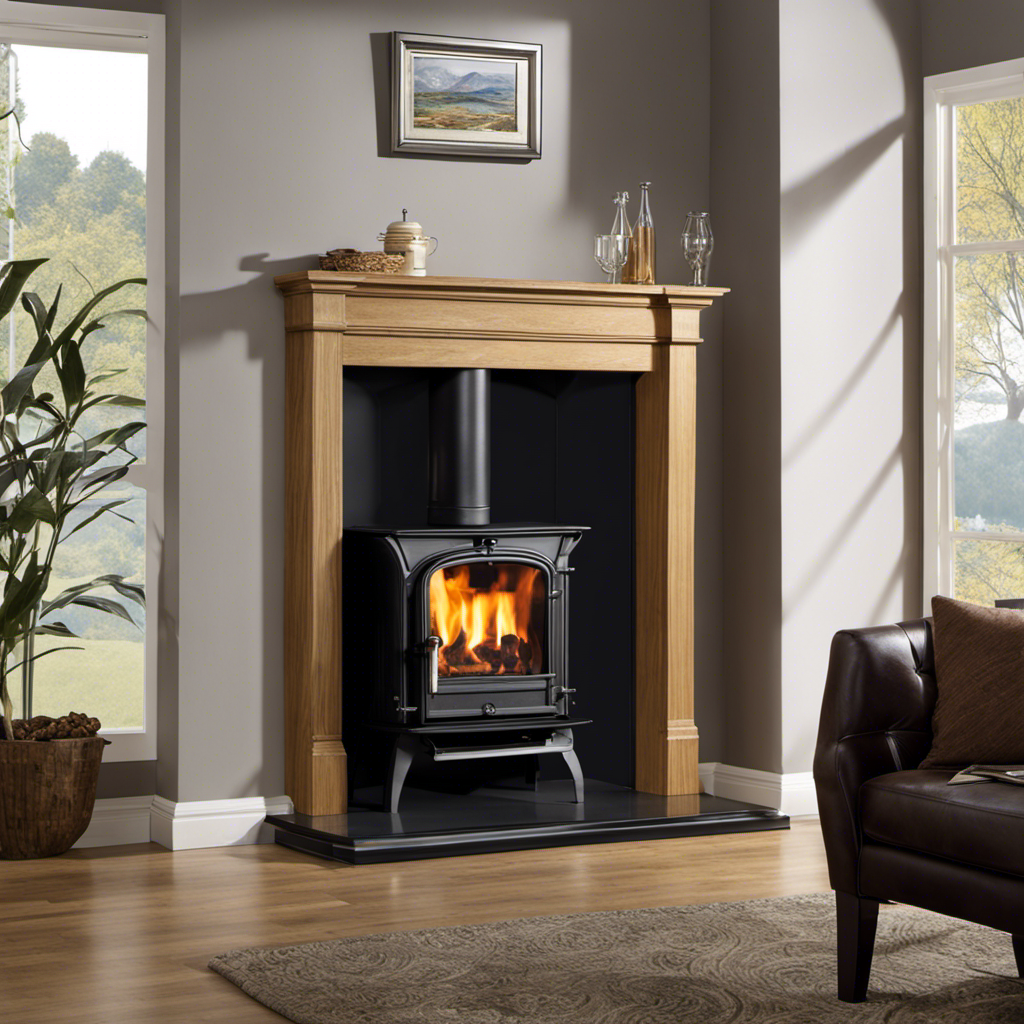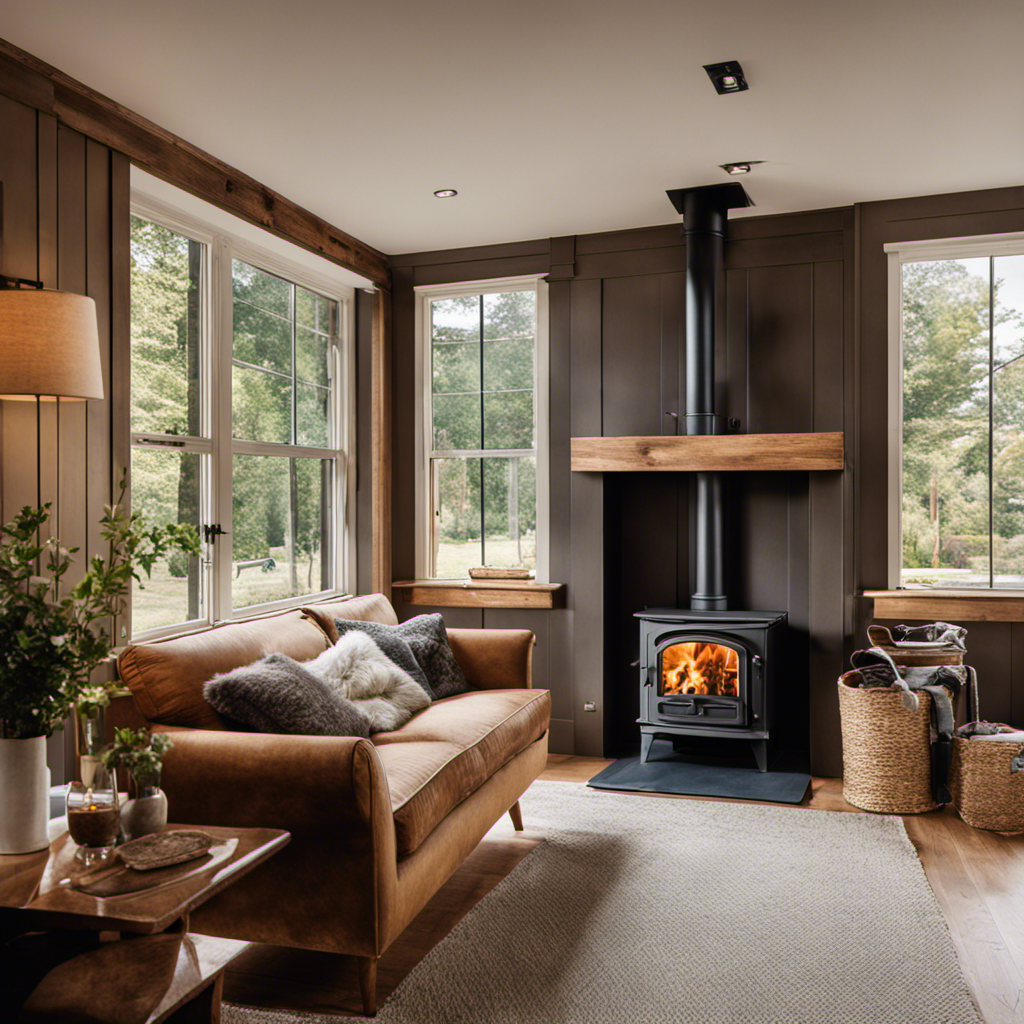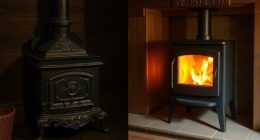Snuggling close to my wood stove, the lively dancing flames evoke feelings of warmth and comfort. Before I can fully enjoy its soothing heat, I must master the technique of effectively warming it up.
In this guide, I’ll share the steps I’ve learned to prepare the firebox, choose the right wood, build a proper fire, control the airflow, and maintain the perfect temperature.
Together, let’s unlock the secrets to turning a cold hearth into a haven of cozy bliss.
Key Takeaways
- Clean out lingering ashes and choose seasoned wood for optimal heat and minimal smoke.
- Stack wood in a teepee shape and use kindling to ignite the fire.
- Adjust air vents to control airflow and monitor the fire through the heat-resistant glass door.
- Use the damper and heat-resistant glass door to maintain heat and maximize stove efficiency.
Preparing the Firebox
I need to open the firebox door to prepare it for starting the fire. Before I can do that, I must make sure to clean out any lingering ashes from the previous fire. Ashes can block airflow and hinder the fire’s ability to burn efficiently. Using a fireplace shovel or a small brush, I carefully remove the ashes and dispose of them in a designated ash bucket.

Once the firebox is clean, I can begin preparing the fire. To make the process easier, I like to use fire starters. These small, compact devices help ignite the fire quickly and efficiently. I place a couple of fire starters, along with some kindling and firewood, in the firebox.
With everything in place, I can now close the door and get ready to start the fire.
Choosing the Right Wood
Before starting the fire, I always make sure to carefully inspect the firewood to ensure I’m choosing the right wood for optimal heat and minimal smoke.
When it comes to choosing firewood, seasoned wood is the way to go. Seasoning wood involves allowing it to dry out properly, which helps to maximize its heat output and reduce the amount of smoke produced. Freshly cut or green wood contains a high moisture content, which can lead to excessive smoke and poor combustion.
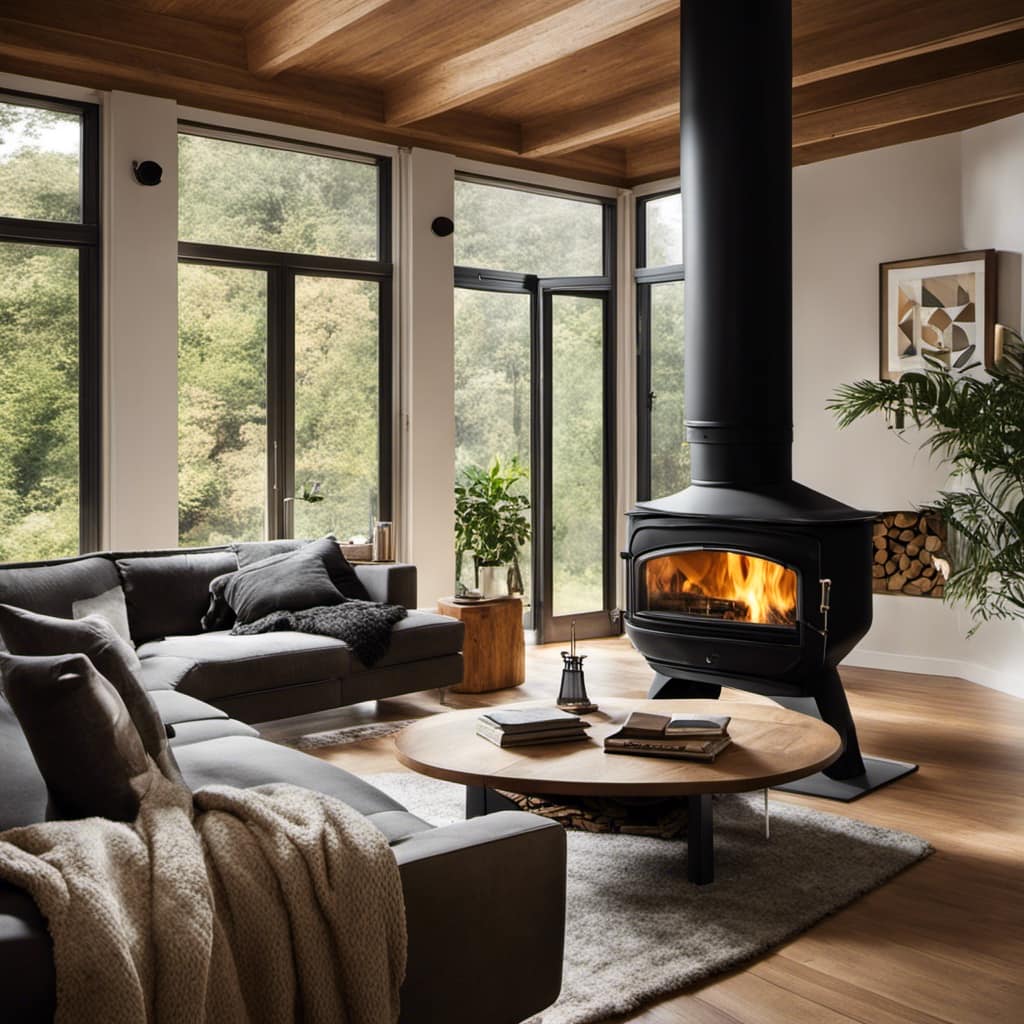
Properly seasoned wood, on the other hand, has had enough time to dry out, resulting in a hotter and more efficient burn. Storing firewood is also crucial in maintaining its quality. It should be stored in a dry and well-ventilated area, such as a woodshed, to prevent moisture from seeping in and causing the wood to reabsorb water.
Building a Proper Fire
To build a proper fire, it’s essential to stack the wood in a teepee shape and use kindling to ignite it. This ensures that the fire gets enough oxygen to burn efficiently and that it will last longer. Fire safety is of utmost importance when dealing with a wood stove. Always keep a fire extinguisher nearby and make sure to properly maintain your stove to prevent any potential issues. Troubleshooting common issues such as a smoky fire or difficulty in starting the fire can be easily resolved by adjusting the air vents or adding more kindling. Remember to never leave a fire unattended and always make sure it’s completely extinguished before going to bed or leaving the house. Stay safe and warm this winter season!
| Fire Safety Tips | Troubleshooting Common Issues | Maintaining Your Wood Stove |
|---|---|---|
| – Keep a fire extinguisher nearby | – Adjust air vents if fire is too smoky | – Regularly clean the stovepipe |
| – Install a carbon monoxide detector | – Add more kindling if fire is difficult to start | – Check for any cracks or leaks |
| – Never leave a fire unattended | – Clear any obstructions in the chimney | – Schedule professional inspections |
| – Ensure the fire is completely extinguished before leaving | – Use dry, seasoned wood for optimal burning | – Follow manufacturer’s instructions |
Controlling the Airflow
Since the temperature in the room was getting too hot, I decided to adjust the air vents to control the airflow.
Adjusting the damper is an effective way to regulate the amount of oxygen that enters the wood stove, thus controlling the intensity of the fire.
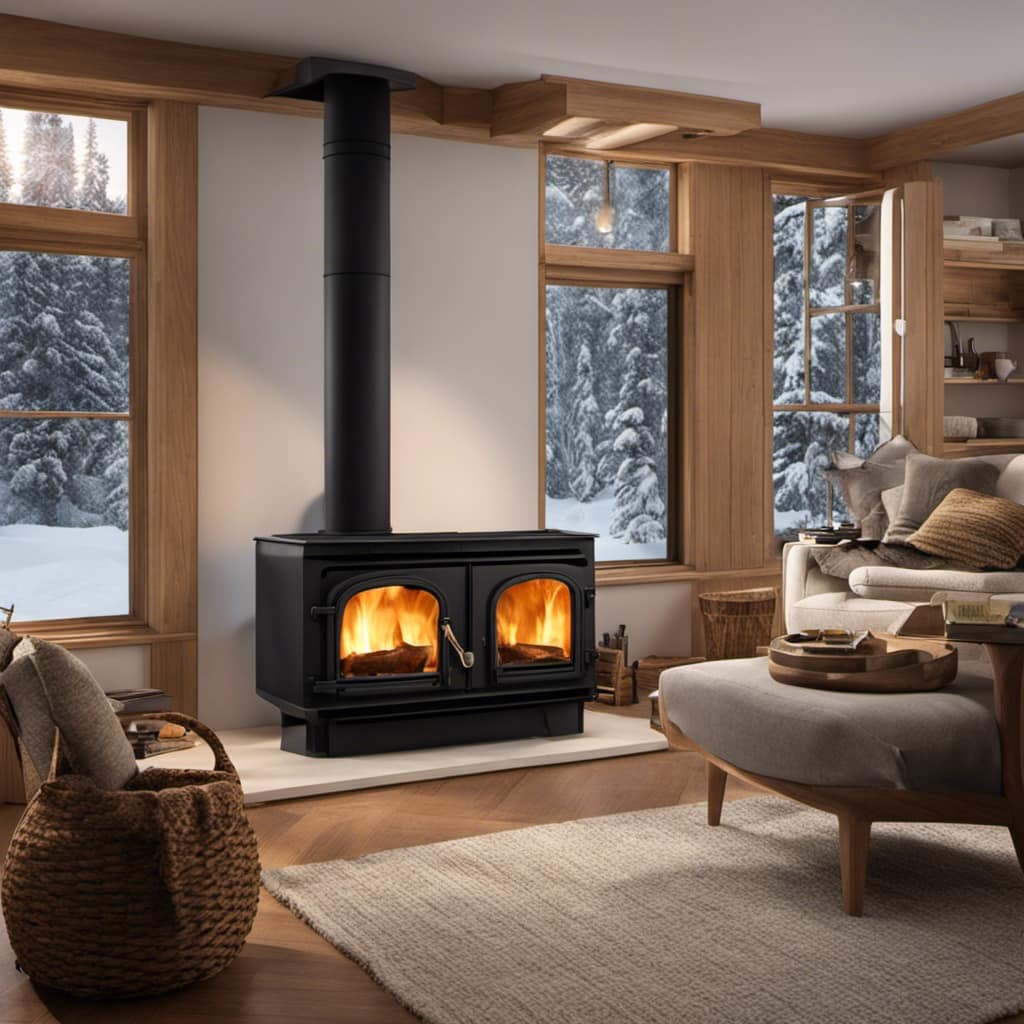
To ensure a safe and efficient operation, it’s important to follow these steps:
-
Start by opening the damper fully to allow maximum airflow. This will help ignite the fire and establish a good burn.
-
Once the fire is burning steadily, gradually close the damper to reduce the airflow. This will slow down the combustion process and lower the heat output.
-
If you have a wood stove with a heat resistant glass door, you can monitor the fire without opening the door and disrupting the airflow. This helps maintain a consistent temperature while preventing excessive heat loss.
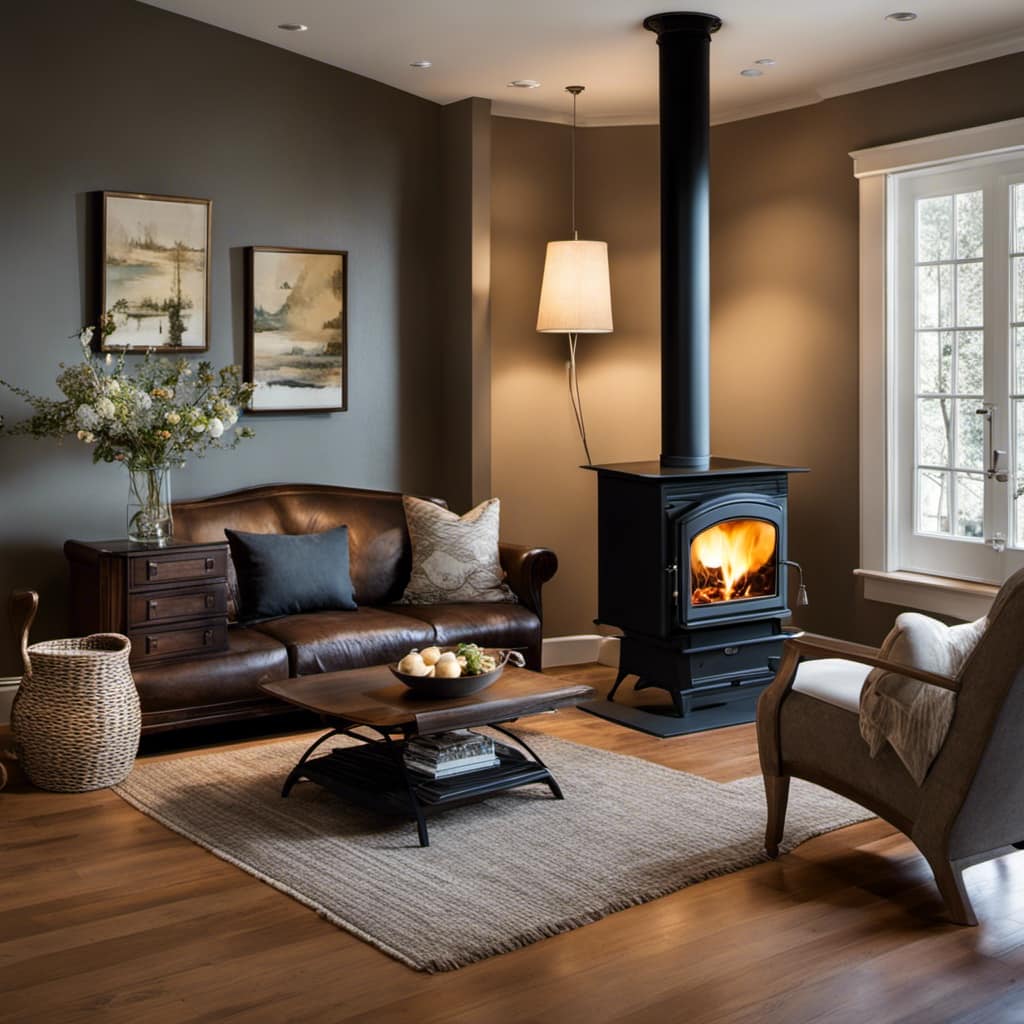
Maintaining the Heat
I can use a damper and a heat resistant glass door to maintain the heat in my wood stove. These two components play a crucial role in ensuring that the heat generated by the fire stays inside the stove and effectively warms up the surrounding area.
The damper, which is typically located in the flue, allows me to control the airflow and regulate the intensity of the fire. By adjusting the damper, I can manage the amount of oxygen that reaches the fire, thus controlling the heat output.
Additionally, a heat resistant glass door acts as a barrier, preventing heat from escaping the stove. This helps to maintain a constant temperature and ensures that the warmth generated by the fire is efficiently utilized.
To further enhance the heat retention, using insulating materials such as firebricks or refractory panels can be beneficial. These materials help to trap and distribute heat evenly, maximizing the stove’s efficiency.

Frequently Asked Questions
How Do I Clean the Glass on My Wood Stove?
Cleaning the glass on a wood stove can be done using various methods. To remove stubborn stains, try using a mixture of vinegar and water or a specialized stove glass cleaner. Regular cleaning will help maintain a clear view of the fire.
Can I Use Newspaper as a Fire Starter?
Sure, newspaper can be used as a fire starter. It’s a popular alternative, but there are other options too. To start a fire effectively, it’s important to follow best practices and choose the right fire starter for your wood stove.
Is It Safe to Leave a Wood Stove Unattended Overnight?
Leaving a wood stove unattended overnight can pose safety concerns. It is important to ensure that the stove is properly maintained, use a fireproof barrier, and follow manufacturer’s guidelines for safe operation.
What Is the Recommended Distance Between a Wood Stove and Flammable Materials?
The recommended distance between a wood stove and flammable materials is crucial for safety. Being knowledgeable about this ensures a warm and cozy home without the worry of potential fire hazards.
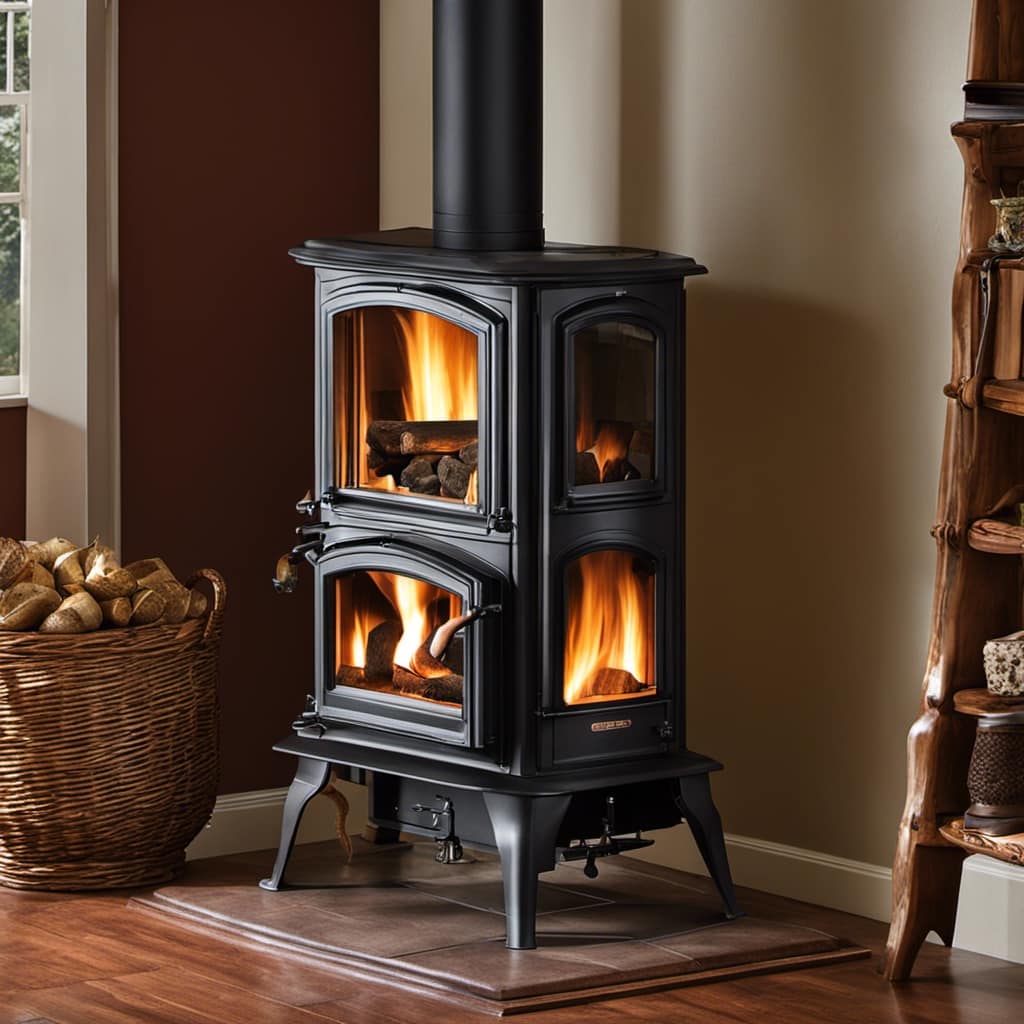
How Often Should I Have My Wood Stove Professionally Inspected and Cleaned?
I typically have my wood stove professionally inspected and cleaned once a year. This is important for proper wood stove maintenance and to ensure that there are no signs of a dirty wood stove, such as excessive smoke or poor burning efficiency.
Conclusion
So there you have it, folks! By following these steps, you can successfully warm up your wood stove and create a cozy atmosphere in your home.
Remember, a wood stove isn’t just a source of heat, but also a symbol of comfort and tranquility.
So go ahead, light up that fire and let the flames dance and crackle, filling your space with warmth and serenity.

Embrace the beauty of a wood stove and let it be the heart of your home.
Growing up surrounded by the vast beauty of nature, Sierra was always drawn to the call of the wild. While others sought the comfort of the familiar, she ventured out, embracing the unpredictable and finding stories in the heartbeat of nature.
At the epicenter of every remarkable venture lies a dynamic team—a fusion of diverse talents, visions, and passions. The essence of Best Small Wood Stoves is crafted and refined by such a trio: Sierra, Logan, and Terra. Their collective expertise has transformed the platform into a leading authority on small wood stoves, radiating warmth and knowledge in equal measure.




